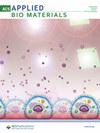Calcium-sensing receptor-mediated macrophage polarization improves myocardial remodeling in spontaneously hypertensive rats
IF 4.6
Q2 MATERIALS SCIENCE, BIOMATERIALS
引用次数: 0
Abstract
Chronic inflammation is a key element in the progression of essential hypertension (EH). Calcium plays a key role in inflammation, so its receptor, the calcium-sensing receptor (CaSR), is an essential mediator of the inflammatory process. Compelling evidence suggests that CaSR mediates inflammation in tissues and immune cells, where it mediates their activity and chemotaxis. Macrophages (Mφs) play a major role in the inflammatory response process. This study provided convincing evidence that R568, a positive regulator of CaSR, was effective in lowering blood pressure in spontaneously hypertensive rats (SHRs), improving cardiac function by alleviating cardiac hypertrophy and fibrosis. R568 can increase the content of CaSR and M2 macrophages (M2Mφs, exert an anti-inflammatory effect) in myocardial tissue, reduce M1 macrophages (M1Mφs), which have a pro-inflammatory effect in this process. In contrast, NPS2143, a negative state regulator of CaSR, exerted the opposite effect in all of the above experiments. Following this study, R568 increased CaSR content in SHR myocardial tissue, lowered blood pressure, promoted macrophages to M2Mφs and improved myocardial fibrosis, but interestingly, both M1Mφs and M2Mφs were increased in the peritoneal cavity of SHRs, the number of M2Mφs remained lower than M1Mφs. In vitro, R568 increased CaSR content in RAW264.7 cells (a macrophage cell line), regulating intracellular Ca2+ ([Ca2+]i) inhibited NOD-like receptor family protein 3 (NLRP3) inflammasome activation and ultimately prevented its conversion to M1Mφs. The results showed that a decrease in CaSR in hypertensive rats causes further development of hypertension and cardiac damage. EH myocardial remodeling can be improved by CaSR overexpression by suppressing NLRP3 inflammasome activation and macrophage polarization toward M1Mφs and increasing M2Mφs.钙传感受体介导的巨噬细胞极化可改善自发性高血压大鼠的心肌重塑
慢性炎症是导致本质性高血压(EH)恶化的关键因素。钙在炎症中起着关键作用,因此其受体--钙感应受体(CaSR)--是炎症过程的重要介质。令人信服的证据表明,CaSR 在组织和免疫细胞中介导炎症,并在这些组织和免疫细胞中介导它们的活动和趋化。巨噬细胞(Mφs)在炎症反应过程中发挥着重要作用。这项研究提供了令人信服的证据,证明 CaSR 的正向调节剂 R568 能有效降低自发性高血压大鼠(SHRs)的血压,通过缓解心脏肥大和纤维化改善心脏功能。R568 可增加心肌组织中 CaSR 和 M2 巨噬细胞(M2Mφs,具有抗炎作用)的含量,减少在此过程中具有促炎作用的 M1 巨噬细胞(M1Mφs)。与此相反,CaSR 的负态调节剂 NPS2143 在上述所有实验中发挥了相反的作用。这项研究之后,R568 增加了 SHR 心肌组织中 CaSR 的含量,降低了血压,促进了巨噬细胞向 M2Mφs 的转化,改善了心肌纤维化,但有趣的是,SHR 腹腔中的 M1Mφs 和 M2Mφs 都增加了,M2Mφs 的数量仍然低于 M1Mφs。在体外,R568 增加了 RAW264.7 细胞(一种巨噬细胞系)中 CaSR 的含量,调节了细胞内 Ca2+ ([Ca2+]i),抑制了 NOD 样受体家族蛋白 3(NLRP3)炎性体的激活,并最终阻止了其向 M1Mφs 的转化。结果表明,高血压大鼠 CaSR 的减少会导致高血压和心脏损伤的进一步发展。通过抑制NLRP3炎症小体的激活和巨噬细胞向M1Mφs的极化以及增加M2Mφs,过量表达CaSR可改善EH心肌重塑。
本文章由计算机程序翻译,如有差异,请以英文原文为准。
求助全文
约1分钟内获得全文
求助全文

 求助内容:
求助内容: 应助结果提醒方式:
应助结果提醒方式:


